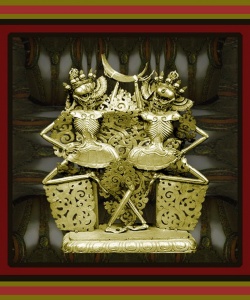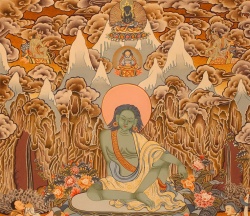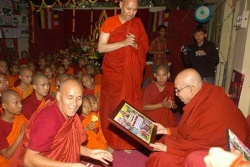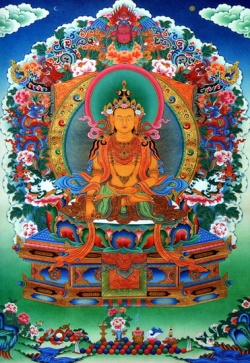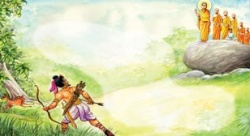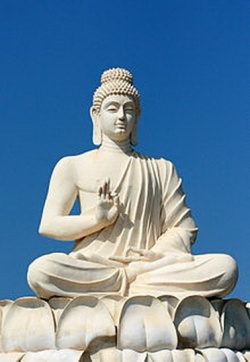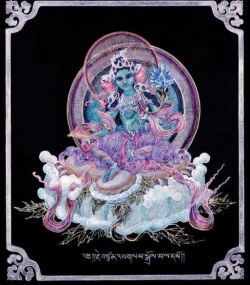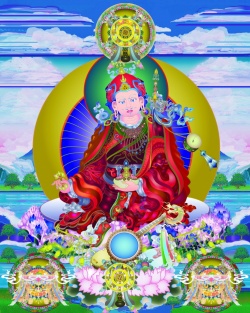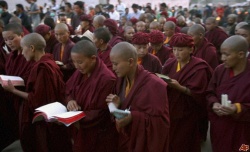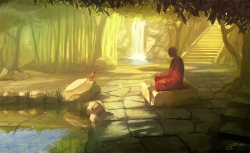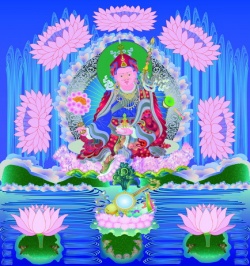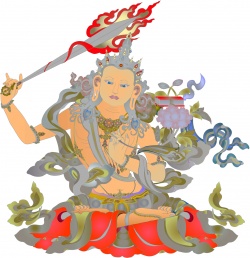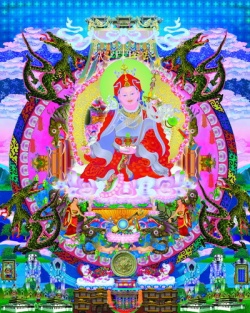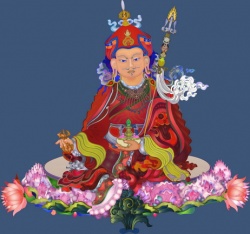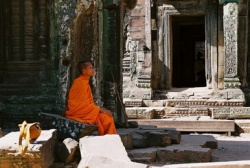Difference between revisions of "A Buddhist Perspective on Lucid Dreaming"
m (Text replacement - "fruitful" to "fruitful") |
m (Text replacement - "{{Wiki|related}}" to "related") |
||
| Line 31: | Line 31: | ||
Elucidated Through a Presentation of the [[Five Skandhas]] | Elucidated Through a Presentation of the [[Five Skandhas]] | ||
| − | The [[first skandha]] relates the corporeality of the [[object]] in terms of the qualities of form/color, [[sound]], {{Wiki|smell}}, {{Wiki|taste}} and {{Wiki|tactility}}, and, the corporeality of the [[subject]], in terms of our [[body]] and especially in terms of the [[physical]] [[sense organs]] and [[faculties]]. The first moment of [[contact]] or [[perception]] of the [[object]], within the ordinary waking state, is through the functional {{Wiki|dynamism}} of the [[first skandha]], our [[physical body]]. Our [[five senses]] individually [[contact]] with the | + | The [[first skandha]] relates the corporeality of the [[object]] in terms of the qualities of form/color, [[sound]], {{Wiki|smell}}, {{Wiki|taste}} and {{Wiki|tactility}}, and, the corporeality of the [[subject]], in terms of our [[body]] and especially in terms of the [[physical]] [[sense organs]] and [[faculties]]. The first moment of [[contact]] or [[perception]] of the [[object]], within the ordinary waking state, is through the functional {{Wiki|dynamism}} of the [[first skandha]], our [[physical body]]. Our [[five senses]] individually [[contact]] with the related qualities of the [[object]]. From the [[senses]] the [[sense]] [[impressions]] go to the five respective [[sense]] [[consciousnesses]]. Neither the [[senses]] nor the [[sense]] [[consciousnesses]] have [[intellectual]] {{Wiki|abilities}}. |
Immediately after the [[sense]] [[contact]], the [[second skandha]], the basic feeling-evaluation ([[Tibetan]] [[tsor-ba]]; [[Sanskrit]] [[vedana]]) which differentiates into [[attraction]] and rejection, sets in. The middle part of the "[[wheel of existence]]," [[symbolized]] by a pig, a doe, and a {{Wiki|snake}}, refers to lack of [[intrinsic awareness]] ([[Tibetan]] [[ma rig-pa]]) and to this basic [[feeling]] differentiating [[attraction]] and rejection ([[Tibetan]] ’[[dod-chags]] for [[attraction]], [[zhe-sdang]] for rejection). | Immediately after the [[sense]] [[contact]], the [[second skandha]], the basic feeling-evaluation ([[Tibetan]] [[tsor-ba]]; [[Sanskrit]] [[vedana]]) which differentiates into [[attraction]] and rejection, sets in. The middle part of the "[[wheel of existence]]," [[symbolized]] by a pig, a doe, and a {{Wiki|snake}}, refers to lack of [[intrinsic awareness]] ([[Tibetan]] [[ma rig-pa]]) and to this basic [[feeling]] differentiating [[attraction]] and rejection ([[Tibetan]] ’[[dod-chags]] for [[attraction]], [[zhe-sdang]] for rejection). | ||
Revision as of 15:46, 31 December 2014
By TARAB TULKU XI
Copenhagen University, Denmark
Editor’s Note: Tarab Tulku, L.R.G.S, Dr.Phil., is a Tibetan lama, the eleventh in-carnation of the Tarab Tulku. Tarab is an abbreviation of the much longer name of a monastery in Tibet. Tulku means "reborn." He has been educated in Tibet at the University of Drepung Monastery, where he received the highest degree, Lharampa Geshe, in Buddhist philosophy and metaphysics, as well as in meditation disciplines (including Tantra). At present Tarab Tulku is the head of the Tibetan section of the Royal Library and of the Tibetan department of Copenhagen University. On the basis of his own profound experience and accumulated knowledge, Tarab Tulku has modified the original Tibetan Buddhist techniques and developed therapeutic methods adapted to Western approaches, still integrating the essence of the esoteric meditation practices of Tibetan Buddhism.
Within the Buddhist Tantric tradition there is great emphasis on using the dream state of being for developmental ends. There exists a special practice called "dream yoga," which in the West has been presented as one of the "Six Doctrines of Naropa." The dream yoga is a high meditation practice which is performed by the practitioner within the so-called lucid dream state.
However, working directly and consciously in the lucid dream state is not accessible to very many people. As the dream yoga methods are very strong and direct methods for development, I have committed myself to developing ways of dealing with dreams, which on the one hand provide training towards actual dream yoga practice—the practicing within the lucid dream state—and on the other hand can fruitfully be used to confront and dissolve problematic psychological structures more effectively than by dealing with these in the ordinary waking state. Therefore, it is appropriate to talk about two different levels of purposes, a surface level of psychological observance, and a more subtle level of spiritual observance.
Psychologically-oriented practices are concerned mainly with changing our general psychological structures with the purpose of decreasing our everyday problems in relation to self and others. In contrast, the spiritual observance level is a practice level mainly concerned with changing our existential existence, with the purpose of decreasing the distance between, and thus uniting, our rational and non-rational abilities, or our feminine and masculine energies, or our body and mind or substance and consciousness. By healing the gaps and finally uniting subject and object we break the dualistic determination and entrapment of our existence, thus entering into the nature of existence, the essential nature of the universe.
It should be noted that distinguishing these two practice levels is provisional. The two levels follow each other sequentially. One must solve one’s major problems on a psychological level before being able to successfully enter the more subtle spiritual level where changing one’s existential structures in relation to reality occurs.
One of the main concerns on a psychological level is to obtain a balance be-tween our ordinary coarse-rational contact with and/or interpretation of reality and a nonrational relation with reality. This balance can be obtained, and has traditionally within Buddhism been obtained, from two alternately used angles:
1. One can use methods to awaken and train the nonrational contact, whereby the coarse-rational contact naturally will be softened, and become less rigid and projective and thus more open and clear; or
2. One can use methods to directly reduce the coarse, rationally created reality, to touch upon and be able to perceive and appreciate a more direct and nonmanipulated relationship with reality, a step which in itself will further a nonrational contact with reality.
During the process of establishing a balance between our ordinary, coarse-rational and the nonrational contact with reality our psychological problems change as they are part and parcel of the coarse-rational creations.
In dealing with dreams, in the dream state in particular, we initially train the nonrational way of contacting reality, using our dream body/mind abilities. With this basis we deal with the dream object—and later again with the dream subject—in different ways, slowly breaking the coarse-rational beliefs as well as many other layers of our dualistic way of existence.
Before I talk about the way I work with dreams, I will briefly be concerned with the creation and dynamism of our ordinary way of being, i.e. the ordinary coarse-rational way in which we contact reality. For this purpose, the foundation of the Buddhist psychology of perception/cognition, characterized by "the five skandhas" is useful. This system describes our psychophysical dynamic being from the perspective of the meeting of subject and object. In other words it is a detailed breaking down of the moments of perception. We also need to concern ourselves with the question of why the dream state is particularly useful for our purposes. Finally, I will present how I find it useful to deal with dreams within the dream state and within the imaginary dream state—methods based on the traditional dream yoga practice.
The Coarse-Rational Way of Contacting Reality
Elucidated Through a Presentation of the Five Skandhas
The first skandha relates the corporeality of the object in terms of the qualities of form/color, sound, smell, taste and tactility, and, the corporeality of the subject, in terms of our body and especially in terms of the physical sense organs and faculties. The first moment of contact or perception of the object, within the ordinary waking state, is through the functional dynamism of the first skandha, our physical body. Our five senses individually contact with the related qualities of the object. From the senses the sense impressions go to the five respective sense consciousnesses. Neither the senses nor the sense consciousnesses have intellectual abilities.
Immediately after the sense contact, the second skandha, the basic feeling-evaluation (Tibetan tsor-ba; Sanskrit vedana) which differentiates into attraction and rejection, sets in. The middle part of the "wheel of existence," symbolized by a pig, a doe, and a snake, refers to lack of intrinsic awareness (Tibetan ma rig-pa) and to this basic feeling differentiating attraction and rejection (Tibetan ’dod-chags for attraction, zhe-sdang for rejection).
The third moment of perception can roughly be described as the "taking in" of the sense-impressions by consciousness. In the ordinary waking state the sense-impressions are not just "taken in" but, especially within our modern, Western, highly materialistic cultures, the sense-impressions are almost simultaneously "taken over" by a consciousness dominated by a coarse-rational approach. This leaves the person with very little if any conscious awareness of the pure sense-impressions.
The coarse-rational consciousness refers to the consciousness which establishes that the perceived object is in accordance with the stored image, and with the name/ connotations of similar, already perceived, objects. All this is created within a certain complex cultural/individual view of reality.
The image we create of an object has first been singled out of its natural inter-connectedness with the whole and given a name. This image, when it is first created, will most often come between oneself and future similar objects "perceived." There-fore, instead of actually perceiving the object, in the ordinary waking state, we mainly perceive our already created image of a similar object, and seldom meet the object more intimately than that.
The naming/language part in itself is most useful. However, in the coarse-rational approach the name/language has a tendency to take over reality, i.e., we give the language more meaning than reality itself. Ontologically, we exchange reality with the map of reality.
Following the "taking in" or "taking over" of the sense-impressions by consciousness, the feeling-discrimination between attraction and rejection referred to above now arises. Pleasant feelings arise when the object in focus seems to nourish and/or protect our image of ourself, and unpleasant feelings arise when our image of ourself is endangered. The coarse-rational contact gives the direction for the feeling-evaluation of oneself and the feeling-evaluation increases one’s belief in the coarse-rational perception/cognition. In general, the feeling-evaluation has the last word in reality proof and in decisions.
When the feeling-evaluation of oneself in relation to the object thus arises, it enhances the further building of a coarse-rational interpretation of the object. For instance, if one first evaluates the object as good and supportive of oneself, one naturally approaches and contacts more or less solely its "positive" sides. If, how-ever, one first evaluates the object as confronting or undermining with regard to one’s image of oneself, one’s interpretation and contact is skewed toward its negative aspects. This description may sound trivial, but it has a great impact on our perception/cognition of reality.
Due to the dynamism between the coarse-rational interpretation and the feeling-evaluation of the object, the different emotions accordingly arise. Here we enter the domain of the fourth skandha, the skandha pertaining, among other things, to mentation/emotion. In this way, we create our coarse-rational emotional reality, which we automatically and more or less subconsciously superimpose of the actual sense impression of the object in focus. This, our creation of reality, is to a great extent fictional, and has often very little in common with the basic "pure" sense-reality.
The fifth skandha, the aggregate pertaining to our basic, consciousness energy refers to the main essence of being. This rnam-shes type of consciousness energy is underlying and gives energy to any psychological/mental function. That is, any kind of perception depends on the rnam-shes basic consciousness energy; the sensing, the coarse-rational perception/cognition, the feeling-evaluation, the emotions, etc. If we take away all the above mentioned psychological/mental functions of the first four skandhas, the consciousness energy as such is still maintained, continuing in and throughout all other states of being. Any of our mental/physical acts pertaining to the first four skandhas leave bag-chags, mental imprints in the basic psycho-physical energy of consciousness. These are carried through into any other state of being, for instance into the dream state of being, from whence they again emerge, being part of the manifest dream.
The coarse-rational, perception/cognition of reality is thus, as pointed out above, not "pure," but gives us a projected view of reality, which always is mixed up with our beliefs, fears, self-protective tendencies, emotional states, etc.
In the beginning of this paper, the importance of first obtaining a balance be-tween the coarse-rational and the nonrational relation with reality was stressed. I referred to "a state of being in relation with reality," which is not so corrupted by the coarse-rational approach, but is in closer connection to the basic psychophysical energy of consciousness, that is, closer to the actual nature of being.
In order to diminish and break coarse-rational creations, we have to use an appropriate kind of consciousness, which works in a different manner. For our purpose we have different natural states: the deep meditation state, the dream/bardo state or the deep sleep/death state of being.
Why the Dream State Is Particularly Useful
for Psychological As Well As Spiritual Observations
The dream state is useful for our purposes due to its subtle qualities. In psycho-logically changing ourselves, it is stronger and more effective to work with our difficulties from a level of "being," which circumvents the coarse-rational domination —as our psychological problems most often are bound up with or are part and parcel with the coarse-rational approach to reality—and also circumvents the limitations of our contact with reality due to our bondage within the rough physical body. If we want to progress in a spiritual direction, change ourselves existentially, change the relation between subject and object towards their unity, then one must transcend both types of limitations.
As we have just shown, our ordinary perception/cognition has a limited contact with the object. This is manifest in different ways. First of all, the perceptive/cognitive process of our ordinary waking state is strongly dispersed. The actual perception through the five distinct senses, though they can have direct contact with the five object qualities correlating with the senses, have no unity in themselves and no intellectual abilities. Further, the coarse-rational consciousness, belonging to the sixth-sense consciousness, has no direct perceptive tools by itself. It has to rely on the sense impressions of the five physical senses and the five sense consciousnesses, on top of which it has a strong tendency to create its own individual reality, differing radically from the ordinary "surface reality" as such. Secondly, the perception/cognition is bound within the physical body and limited accordingly, i.e., it is space- and time-limited.
In the dream state, as well as in the deep meditation state, perception and cognition are united. The sense-impressions are not functionally distinct. They are not dependent on the physical sense organs, but operate directly from within the sixth-sense consciousness. That is to say, the five sense consciousnesses and the sixth-sense consciousness operate naturally in union in the dream/meditation states of being—implying a natural basis for uniting body/mind and subject/object. In general, within the Tibetan Buddhist tradition, body and consciousness always need to work together. A body doesn’t work without a consciousness, and a consciousness doesn’t work without a body.
In the dream state and deep meditation state, we also have/are a body. However, the dream body and the body in the deep meditation state, often named the subtle body, are not of coarse physical nature, but are energy bodies, and have therefore the ability to go beyond the ordinary limitations and bondage of the physical body, i.e. beyond space and time fixations.
An energy body can be characterized as a unity of the basic energy of our physical body and the basic mental energy of consciousness. In the ordinary waking state we naturally also have the energy body, but we are normally unaware of it. In general, we only use our coarse physical body in cooperation with our coarse-rational consciousness, in which state our physical and mental aspects of being are strongly separated.
In any Tantric meditation, we try to awaken and train an energy body—for example, through awakening the energy in the chakras, etc. In the Six Doctrines of Naropa there is a specific Tantric practice where you train the "illusory body" (Tibetan sGyu-lus). The illusory body is a very subtle energy body, which can be established through deep meditation. Through the sGyu-lus practice one can leave the rough physical body, enabling one to use the subtle body without interference. However, it takes a long time and is very difficult to be able to awaken and train the sGyu-lus from the waking state of being. In general, when we try to awaken and train our energy body from the waking state, the physical body constantly interferes. It is very difficult not to take notice of the physical body, as we are used to identifying with and greatly caring about it.
However, in the dream state we have already parted from the rough physical body and we naturally have an energy body (the dream body). Because the dream state naturally occurs in every sleeping period, the Tantrics therefore make use of the dream state in order to develop and practice use of the subtle body.
However, though our more subtle abilities are naturally present in the dream state, we are ordinarily, in this state, still dominated by our normal, coarse-rational and dualistic views and beliefs of separation between body and consciousness. So in order to be aware of and be able to use the abilities of the dream state, we need to train our dream body and dream consciousness. We will now turn to this training.
Dreamwork Within the Dream State and Within the Imaginary State of Being—
Methods Based on the Traditional Dream Yoga Practice
Preliminary to dream yoga, the practitioner must be acquainted with the dream world, remembering dreams and having clear dreams. For psychological reasons it is also very important to remember one’s dreams. In the waking state we reject re-pressed conflicts and fears which we find difficult to deal with. However, these conflicts and fears, among all acts pertaining to the first four skandhas, leave imprints in the basic psychophysical energy of our consciousness, and reappear in the manifest dream in order to be lived through in this level of being. I find that living through psychological difficulties is the natural psychological function of dreams.
Stage One
The first stage of dream yoga is "holding the dream." This stage implies the training of lucid dreaming—to know the dream is a dream while dreaming.
In order to experience lucid dreams whenever desired—not just at random—the practitioner has to train her will power to be able to go consciously into the dream state. Also she needs to awaken and balance her subtle energies.
Roughly we can talk about three "chakra" energies. The qualities of the chakra energies can be respectively expressed and distinguished in the following way:
1. An active type of energy, the rational-intellectual, the birth-creation, male type of energy.
2. A nonactive, nonoutgoing type of energy, nonrational, like the Death energy, which is female. The Death-consciousness is the subtlest form of consciousness.
3. The third energy type balances between the active and nonactive.
People who mainly use the intellect or rational energy while asleep have to use methods of first getting into the nonrational (Type 2) energy. Getting into the non-rational energy on the threshold of sleep has different effects in the dream state, among which the most important for now are:
1. The sleeping state comes at rest and will therefore function naturally, fulfilling its function, i.e., the mental imprints (which for the reason of our mental health/healing need to come out and be lived through or worked through in the dream state);
2. Through nonrational energy one can develop lucidity and train to use one’s powers in the lucid dream state.
However, when the dream state is at rest and the will-power created, the practitioner needs to get more into the active (Type 1) energy in order to create the clear dream and in order to be more consciously aware in the dream state experiencing the lucid dreaming.
But if the practitioner gets too much into active energy, she will wake up. She therefore needs to hold a fine balance between the non-active and the active energy, using the Type 3 energy in order to stay in the lucid dream, neither waking up nor falling back into the ordinary dream flow.
Stage Two
The second stage is "mastering the dream." In this stage, knowing the dream is a dream while dreaming, the practitioner develops his own power of using his dream body with volition. This enables him to deal actively with the dream object in a way, which is similar to the way we deal with the object while awake.
The first step in obtaining the power of mastering the dream body is to consciously be the dream body, as ordinarily we are being our physical bodies. Being the dream body still requires training the practitioner how to use it. He needs to get all the senses to work properly and to be able to move the dream body at will.
Next the practitioner trains his willpower through the dream body in order to further investigate that which captures his interest. When this step is mastered he has the ability to acknowledge disturbing psychological structures emerging in the dream, and further, he has the ability to work directly in the dream state with them.
In this context, I will mention some methods the practitioner can use to work directly with fear when confronted with negative aspects in the dream scene (the dream object), and discuss how/why these methods work. The practitioner is ad-vised never to flee the negativity, but to either fight it, or better still, to let the nega-tivity destroy himself. In other words, unite with negativity. In order to understand why these methods work, we must understand the dynamic between negativity and the subject being confronted by it. Here we have to reach back to the basic psychology presented earlier under the third skandha, where we found that pleasant feelings arise in contact with the object when the object seems to nourish and/or protect our image of ourself, and unpleasant feelings arise when our image of ourself is endangered. Thus, within my interpretation and experience, the negativity frightening the practitioner in the dream is a picture/representation of the practitioner’s fear of having his self-image destroyed.
If a practitioner flees a negativity, he misses the opportunity to work with his self-image and with the fear of having it destroyed. Instead, through this action he manifests his self-image even further. Secondly, if the practitioner fights that which will destroy his self-image, he creates a feeling of being protected in himself, and he will therefore feel stronger both in the dream, and also, it would seem, in waking reality. Thirdly, the practitioner can let a negativity destroy himself in the dream, i.e. he can unite with the negativity. When a negativity destroys the dream subject, it destroys that which the practitioner identifies with and therefore wants/needs to protect, his self-image. However, when this is destroyed the practitioner goes beyond this image of himself and reaches a more authentic layer of his being. No longer identifying with the image, there is nothing to maintain the game of fear and negativity, which is why there no longer is any fear or negativity. The practitioner has united himself with his fear and negativity. Through this act, it seems to me, he has resolved underlying psychological problems.
Having obtained the ability to "master the dream" it is possible for a practitioner to do many different and possibly unusual things within the dream. If, for instance, the practitioner wants to understand certain things, it could be within the sciences or within philosophy, psychology, the arts, he can—through various methods—contact or tune into "energy-lines" of the knowledge he wants to acquire. The dream state gives special possibilities to do so, due to its naturally stronger unity between body/mind and subject/object.
Stage Three
The third stage is "changing the dream." I mentioned above that the core point in the dream yoga was to break or go beyond our dualistic way of existence. In this stage the practitioner is supposed to start directly breaking some of our strongest beliefs: the belief in the solidness and absoluteness of the object, the belief in our separateness from the object, the belief in time linearity and space fixation. Thus, in order to change the dream object, a practitioner has to train herself to go within the will power of her dream body/mind, contacting the basic structuring energy through which she can contact the dream object of the same energy level. On this very subtle structuring level of being, there is a correspondence between the energy of the subject and the object, through which direct contact is possible. Through this direct energy contact the practitioner can change the object, and/or can create objects at will.
In order to learn how to go into this subtle structuring level of being, the practitioner is traditionally instructed to use different deity-meditations in the dream state. However, to use these, certain initiations are required. When the practitioner can tune into this subtle structuring energy of the subject and the object, and use it for changing the object, she is breaking the ordinary natural laws of separateness. After obtaining this ability, a practitioner is able, by her will power and unity abilities, to transcend ordinary space and time limitations.
When the practitioner was working with the dream object, she had to work from her more rational/active chakra energy side, still keeping a balance in order not to awake from the dream state. But approaching the training of the unity abilities of subject/object, the practitioner is advised to work more through the nonrational, nonactive, feminine energy side.
As I have mentioned before, different levels of imprints, of more or less prob-lematic observances, give rise to the main part of the dream. Having sufficiently mastered the dream, the practitioner naturally and spontaneously does seem to know which method to use in successfully dealing with dream appearances, and through these with the underlying consciousness energy. These needed to come out to be lived or worked through. After having mastered the methods of changing dream appearances, the practitioner can now change unwanted, unpleasant dream situations or her dream being. This act seems to have a direct healing impact on the underlying psychological difficulties associated with her waking life.
Stage Four
The fourth and last stage of dream yoga is to "merge with the unity of the subtle body/mind." Here the practitioner is no longer working with the dream object/apearances. He now works directly through the unity of the subtle feminine and masculine energies of his dream subject, going beyond dream appearances. From this state of being, which is closely connected with the above mentioned state of "the illusory body," the practitioner works directly with his relationship to the waking state reality, also breaking the ordinary natural laws of the reality of the waking state.
Dream Reliving
As mentioned in the beginning, it is not so easy to traverse the steps of knowing the dream is a dream, being able to create lucid dreams at will, or going consciously into the dream state of being.
Instead of working directly in the dream state, I have found it useful for the practitioner first to work with the same methods in the imaginary dream state of being. The imaginary dream state is a deeply relaxed state from which the practitioner enters a recalled dream with which she wishes to work. However, it is much more effective to work with the dream from the dream state than to work with the recalled dream from the imaginary dream state. The dream state is more subtle than the imaginary dream state. The imaginary dream state is more easily influenced by the view of the coarse-rational consciousness. However, psychologically speaking, if the practitioner is able to enter the imaginary state and not be disturbed or influenced by the coarse-rational view, then it seems fruitful for her to train and apply the dream yoga methods in the imaginary dream state.
To advance on the spiritual levels, i.e., existentially changing the dualistic way of existence, breaking the natural laws, etc., it is, of course, difficult to work from the imaginary dream level due to the possible interference of the ordinary coarse-rational dualistic view. However, some progress certainly takes place when the methods are properly used.
In general, it should be clear that any practice towards awakening and developing the subtle energies of body/mind, whether through the imaginary dream state, training the imaginary dream state or training the chakra energies, has a great impact on the ability of a practitioner to create clear dreams, and to further the dream power necessary for creating lucid dreams at will, and to work directly with the dream appearances in the dream.
References
Ajitamitragupta (1981). The Tibetan Tripitaka, D.G. edition, no. 2832: Rmi-lam dri-ma med-pa bsgom-pa. Dharma Press USA. [Note: Provides information on Rmi-lam bsgom-pa, the "Dream Yoga."]
Dharmakirti (1981). The Tibetan Tripitaka, D.G. edition, no. 4210: Tshad-ma rnam-hgrel gyi tshig-lehur byas-pa (The Tibetan translation of Pramanavarttikakarika.) Dharma Press USA. [Note: Provides information on ’Du-shes (the rational/coarse-rational conscious-ness) and mNgon-sum (the nonrational consciousness with respect to direct perception of the yogi mind).]
Dignaga (1981). The Tibetan Tripitaka, D.G. edition, no. 4204: Tshad-ma kun-las btus-pahi hgrel-pa (The Tibetan translation of Pramanasamuccayavrtti). Dharma Press USA. [Note: Provides information on ’Du-shes (the rational/ coarse-rational consciousness) and mNgon-sum (the nonrational consciousness with respect to direct perception of the yogi mind).]
rGyal-tshab dar-ma rin-chen (1974–1975). Tson-kha pa’s collected works, vol. ca: Rnam-hgrel gyi bsdus-don, Thar-lam gyi de-ñid gsal-byed. Printed in Barasasi, India. [Note: Provides information on ’Du-shes (the rational/coarse-rational consciousness) and mNgon-sum (the nonrational consciousness with respect to direct perception of the yogi mind).]
Tson-kha pa (1979). Tson-kha pa’s collected works, vol. ta: [[Zab-lam na-rohi chos-drug gi sgo-nas hkhrid-pahri rim-pa, yid-ches gsum Idan & Na- rohi chos-drug gi dmigs-skor lag-tu len tshul bsdus-pa. New Delhi, India. [Note: Provides information on Rmi-lam bsgom-pa, the "Dream Yoga," and the sGyulus, the "Illusory Body."]
